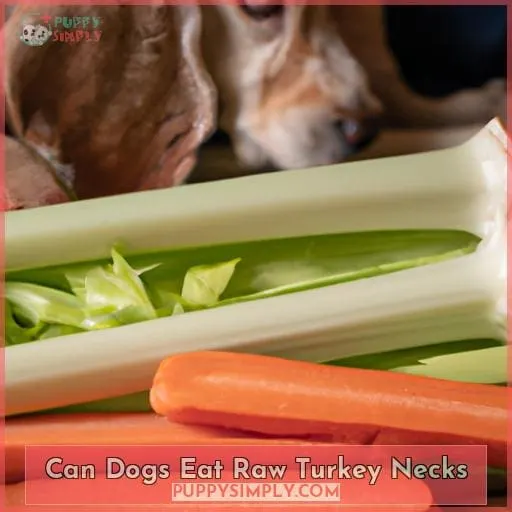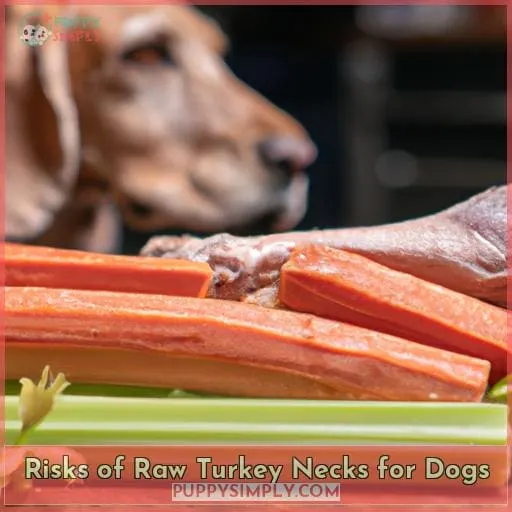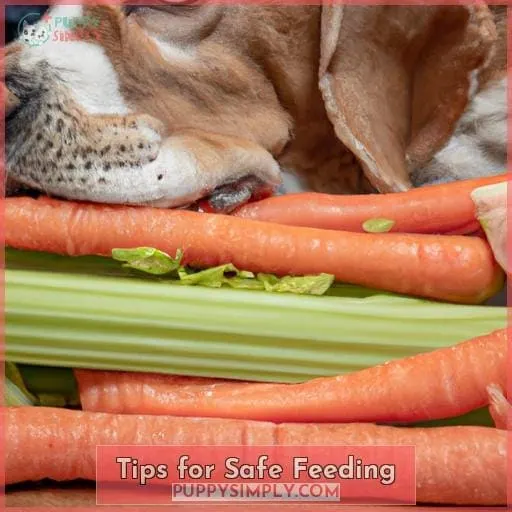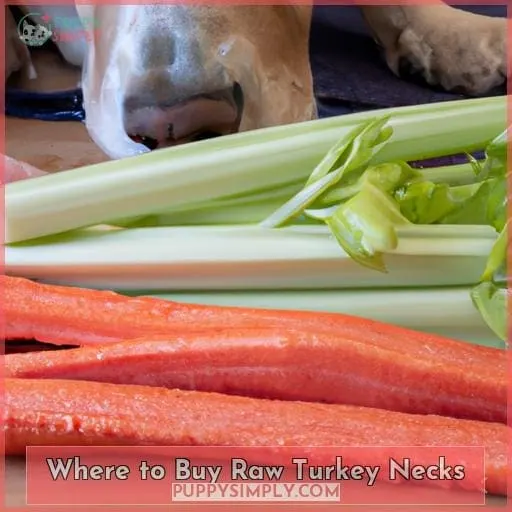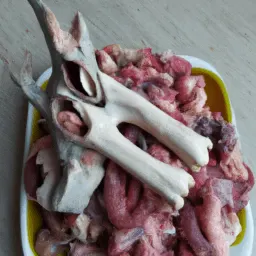This site is supported by our readers. We may earn a commission, at no cost to you, if you purchase through links.
Raw turkey necks can be a great addition to your dog’s diet. They provide essential nutrients and mental stimulation. Plus, they offer glucosamine for joint health, which is especially beneficial for older dogs with arthritis or other mobility issues.
They’re an excellent source of protein, fat, vitamins and minerals such as calcium, phosphorus and B vitamins.
But there are also potential risks associated with feeding raw turkey necks that you should be aware of.
In this article, we’ll discuss the benefits and risks of these unique treats so you can decide if they’re right for your pup.
Table Of Contents
Benefits of Raw Turkey Necks for Dogs
You may have heard about the benefits of feeding your dog raw turkey necks as part of their diet. It’s true they offer a range of nutritional, joint and mobility, dental health, mental well-being and overall health benefits.
Raw turkey necks are a rich source of protein, plus glucosamine for healthy joints, calcium to help prevent plaque buildup on teeth, B vitamins for neurological function, iron to aid in energy production, copper to support immune system functioning, selenium for antioxidant protection against cell damage – all while providing physical exercise through chewing.
In addition to the physical benefits, these treats can also provide an emotional outlet when given at appropriate times throughout the day as part of regular playtime or training sessions.
Nutritional Benefits
By providing essential nutrients, such as protein, glucosamine and chondroitin, calcium, phosphorous and trace minerals in a fully digestible chew form, raw turkey necks can be an excellent addition to your pup’s diet. Not only do they provide a delicious snack for dogs of all ages, but they also offer numerous health benefits. The high-quality proteins help build muscle mass while the fat content provides energy. They’re full of antioxidants which protect cells from free radicals and offer vitamins like Vitamin D to support healthy bones and teeth.
These natural chews contain connective tissue rich in collagen, promoting joint health with anti-inflammatory properties. Glucosamine and chondroitin also help reduce arthritis pain symptoms, making them ideal dental chews too!
Joint and Mobility Benefits
Enjoy the joint and mobility benefits that come with giving your pup a chew of raw turkey neck! Raw turkey necks are an excellent source of bone health for dogs, containing essential trace minerals such as calcium, phosphorous, and glucosamine. Glucosamine is naturally found in these bones and helps keep the joints healthy by providing lubrication.
Remember portion sizes when feeding your dog raw turkey necks; too much can lead to digestive issues due to their high fat content. Balance is key. Don’t let treats replace meals in a canine’s diet.
Turkey necks should always be served at room temperature or lower cooking temperatures to preserve nutrients like glucosamine and ensure safety. Avoid high cooking temperatures altogether if possible.
This treat also provides physical exercise through chewing. This stimulates jaw muscles throughout different parts of the body including legs, shoulders, back, etc. without compromising on flavor or nutrition!
Dental Benefits
You can give your pup the added dental benefits of a raw turkey neck. It helps remove plaque and tartar build-up while providing essential nutrients at the same time. By feeding one dehydrated turkey neck 1-2 times a week, you can help prevent dental disease in dogs; 76% of all canines in the US are at risk.
The bone quality and connective tissue found in this treat are great sources for calcium, phosphorus, B vitamins, iron, copper, selenium, and zinc – all important elements that contribute to healthy teeth when managed properly along with regular weight management practices.
Turkey necks also contain glucosamine and chondroitin, which act as building blocks for cartilage health and joint function support – an additional bonus.
When shopping at farmers markets or butcher shops, be sure to practice safe food handling techniques, such as carefully cleaning surfaces after use or washing your hands before, during, and after handling these products.
Chicken necks make suitable alternatives, but remember they should only be given occasionally due to their higher calorie content than other treats. Always research nutrition analysis prior if considering incorporating them into your canine’s diet plan.
Mental and Overall Health Benefits
Chewing on a raw turkey neck can provide your pup with mental enrichment, relief from stress, and essential nutrients for overall health – it’s a real boost to their well-being!
It’s rich in protein and fat which help promote gut health, as well as bone-strengthening calcium, glucosamine and chondroitin for joint support.
Chewing on the natural fibers of the neck reduces stress levels and provides muscle mass benefits such as weight loss due to increased activity.
Turkey meat production means dogs benefit from additional dental hygiene when consuming them regularly, since they remove plaque buildup naturally without any additives or hormones found in commercial chews.
Risks of Raw Turkey Necks for Dogs
Feeding raw turkey necks to dogs carries some risks. Bacterial contamination, choking, constipation, and obstruction can all occur if the neck is too large or swallowed whole. It’s important to assess your dog’s needs before feeding them any type of bone product. This’ll ensure their safety and wellbeing.
Bacterial Contamination
By being mindful of potential bacterial contamination, you can ensure your pup remains healthy and safe while enjoying the many benefits of natural chews like raw turkey necks. Infection prevention is key when feeding any type of raw meat to dogs, and there are several food safety guidelines that should be followed.
First and foremost, store turkey necks in a freezer until ready to use. Thaw under high temperatures or in the refrigerator before serving. Always wash hands thoroughly after handling raw meat products such as duck or turkey necks for dogs (see table below).
Additionally, it’s important to supervise your dog while they chew on their treat so that they don’t choke on large pieces or swallow bone fragments whole which could lead to constipation or even intestinal blockages requiring veterinary intervention (see feeding guidelines below). Other options include duck necks which are also fully digestible but smaller than those from turkeys making them better suited for small breed pups who might struggle with larger treats.
Hygiene Practices:
- Wash hands thoroughly after handling raw meat products for pets.
Food Safety Guidelines:
- Store all pet food items safely away from human foods.
- Use different cutting boards & knives specifically designated only for pet foods prep work especially if you prepare homemade diets at home where cross-contamination risks are higher.
- Defrost only what will be consumed within 2-3 days max – this reduces spoilage risk by limiting exposure time outside cool storage conditions when bacteria thrive best once thawed out too long! Keep track using labels indicating date defrosted/leftover portions stored).
Storage Tips:
- Avoid re-freezing leftover amounts since each freeze-thaw cycle degrades quality further leading faster decomposition rates.
Remember: High-quality protein sources like poultry bones have numerous health benefits; however one must always take necessary precautions by practicing good hygiene habits, maintaining proper storage techniques as well as avoid feeding raw turkey necks to puppies or dogs with pre-existing medical conditions such as weakened immune systems.
Choking
When feeding your pup treats like turkey necks, always be mindful of potential choking hazards and supervise them while they chew. To reduce the risk, practice safe food hygiene, like cleaning surfaces thoroughly and washing hands after handling raw meaty bones. Select a bone size appropriate for your pet’s mouth; cats have small mouths so avoid poultry bones. When buying animal sources from farmers markets or butcher shops, ensure there’s proper preparation time that meets safety guidelines before serving. Buy products sourced in the USA, free from antibiotics, hormones, additives, colors, fillers, and preservatives when possible, as these can increase risks associated with feeding raw poultry bones safely.
Constipation and Obstruction
Are you aware that improperly digested bone fragments can cause constipation and intestinal blockages in your pet? Feeding raw turkey necks to dogs can be dangerous if not done properly.
Take precautions when preparing the neck by freezing or thawing it at an appropriate temperature for the recommended time frame. This will help reduce risk of contamination with harmful bacteria such as Salmonella and E.coli, which can cause serious health issues for your pup.
Make sure the meat is of good quality and free from bacteria. Give them only one turkey neck per week due to its high calorie content. Provide them with chews of an appropriate size, depending on their breed size – larger breeds need bigger pieces than smaller breeds.
Consider alternative treats such as VOHC accepted dental chews or chicken necks if needed. These are safer options than giving large amounts of raw poultry necks without following preparation guidelines.
Tips for Safe Feeding
To ensure your canine companion enjoys the nutritional benefits of raw turkey necks while avoiding potential risks, be sure to follow these safe feeding tips:
Make sure the bone size is appropriate for your dog’s mouth. Turkey necks are larger than duck and chicken necks, so they’re best suited for medium, large, or giant breed dogs.
Practice proper food safety measures when handling raw bones and dehydrated turkey necks. Wash surfaces before and after contact with these products, and wash your hands thoroughly afterward. Avoid cross-contamination with other foods in preparation methods, as well as storage containers or areas within the kitchen space.
Ensure you’re giving a quality product from reputable sources, such as those produced in the US free from hormones, antibiotics, additives, colors, fillers, and preservatives. This helps maintain healthy skin, fur coat, joints, teeth, digestion, and immune system, just to name a few!
When buying freeze-dried or dehydrated turkey necks, look out for products imported from China. Instead, opt for ones sourced locally and made only using human-grade ingredients, like 100% pure turkey meat – no rendered meats here!
Where to Buy Raw Turkey Necks
If you’re looking for a healthy and natural way to give your pup some variety in their diet, raw turkey necks are an ideal option! They offer many nutritional benefits, including high-quality protein, glucosamine and chondroitin, calcium, phosphorous, and other trace minerals.
Raw or dehydrated turkey necks are part of the raw feeding movement in the US. They provide essential nutrients and act as dental chews, helping to remove plaque build up from your dog’s mouth.
When buying them, consider safety concerns such as avoiding products imported from China. Also be aware of dietary concerns like cost and serving sizes appropriate for each individual breed size.
Prepare them correctly to make sure all parts fit comfortably into your dog’s mouth without causing choking hazards.
Alternatives to Raw Turkey Necks
If you’re looking for something similar to raw turkey necks, try VOHC accepted dental chews, bully sticks or chicken necks as alternatives. Homemade snacks made from frozen bones can be a good option too – just make sure they’ve been cooked thoroughly before feeding them to your dog.
Dehydrated treats such as dehydrated poultry bones and meat grinders are also a great way of adding variety to your pet’s diet but should only be given occasionally.
Alternatively, fresh or dehydrated turkey neck is another excellent choice if you want an easily digestible chew for your dog with added nutritional benefits like glucosamine and chondroitin. You can find these in farmers markets, butcher shops or online stores that specialize in pet supplies; however, it’s important not to buy any imported product from China when buying freeze-dried treats.
For those who have large breed dogs at home, may consider giving them whole pieces of fresh turkey neck while small breed owners could opt for using kong toys filled with smaller portions of dried food instead, since they tend to last longer than raw ones would normally do!
Frequently Asked Questions (FAQs)
How much raw turkey neck should I feed my dog?
You can give your pup a taste of turkey neck as an occasional treat, but it’s important to exercise caution. A raw turkey neck is a moderate-to-high calorie snack that should never replace their complete and balanced diet.
Smaller dogs may be better suited with chicken necks for safety reasons, while larger breeds can benefit from the extra glucosamine and chondroitin found in this crunchy chew – which keeps their joints healthy while exercising with them! It also aids in keeping those pearly whites clean due to its abrasive texture brushing against the dog’s mouth during playtime.
Feeding habits should always take into account each dog’s digestive health history and size; no bones about it!
Is it safe to feed raw turkey necks to puppies?
It is not recommended to feed raw turkey necks to puppies due to their higher risk of choking, as well as the fact that it could be too large and hard for them. Commercial products like freeze-dried or dehydrated turkey necks are available but should only be given occasionally as a treat since they’re quite high in calories. Always provide plenty of fresh water when giving dogs freeze-dried or dehydrated chews.
Bones vs meat can also play an important role in puppy dental care; bones help remove plaque from pup’s teeth while cooked turkey neck can present a greater choking hazard than its raw counterpart if swallowed whole without proper chewing, with their mouth closed. So supervision is key! Surface cleaning before and after handling these products is important.
Are there any special storage instructions for raw turkey necks?
When it comes to storing raw turkey necks, the most important thing is to ensure they are kept at a safe storage temperature. Raw turkey necks should be stored in the refrigerator or freezer in an airtight container and consumed within 3-5 days of purchase for maximum freshness.
Before feeding your pup raw turkey necks, sanitizing preparation is recommended such as washing hands before and after handling any food product for dogs.
When deciding on a serving size and feeding frequency for your pup, consider their age, current diet plan or activity level as well as what type of products you have purchased (freeze-dried vs dehydrated).
Feeding guidelines can vary depending on the size of Turkey Neck product being served. However, giving small amounts twice per week can help adjust them to this new healthy addition into their diet.
Remember that introducing new foods slowly over time helps protect pups’ teeth from damage caused by crunchy treats like these, while also providing essential nutrients needed during growth periods!
How often can I feed my dog raw turkey necks?
Raw turkey necks can be a great way to add variety and essential nutrients to your canine’s diet. They’re high in calories, so feed them occasionally as a treat. Supervision and the right size chew is important, as they may carry risks of choking or intestinal blockages due to bone fragments.
Generally, one dehydrated neck per week is enough for medium-sized dogs. But this depends on inoculations against bacterial contamination such as Salmonella and E.coli, handling precautions during meal prep, the pup’s dental health (chewing helps remove plaque from teeth), joint health (glucosamine & chondroitin help with inflammation), feeding frequency (feeding too much can lead to weight gain) and any special raw feeding considerations specific to your pooch’s dietary needs.
Are raw turkey necks a natural source of glucosamine and chondroitin?
Yes, raw turkey necks are a natural source of glucosamine and chondroitin. Countless studies have shown these growth factors support bone health in dogs. Providing your pup with quality control poultry products from the USA ensures they get the best nutrition possible and reduces the prevalence of dental disease. The digestive enzymes in raw turkey neck help break down large pieces easier than other chews, making them safer for your pup’s teeth. With vet advice on dosage and frequency, plus careful supervision, it’s no wonder why pet owners opt for this natural remedy over pills or supplements.
Conclusion
Feeding raw turkey necks to your dog can be beneficial. But, there are risks like bacterial contamination, choking, and intestinal blockages. It’s important to consider these risks before making a dietary change. If done properly, it can provide numerous health benefits. Are the risks worth it? It’s up to you to decide what’s best for your four-legged friend. Research thoroughly, follow safety guidelines, and consult a vet before making any changes.

